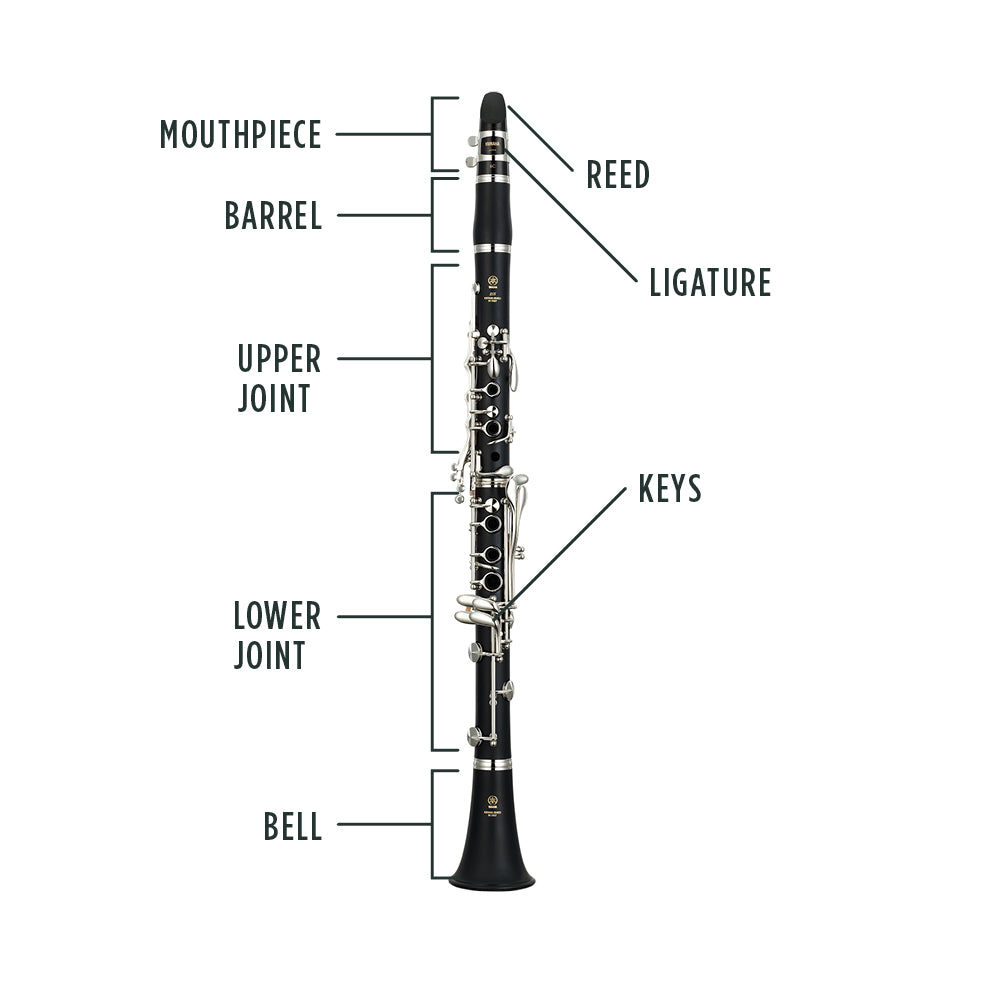About Instruments

Piccolo
Family:
WoodwindKey:
CAs the flutes little sibling, the piccolo (or "small" in Italian) is a half-sized version of the flute with similar fingerings. The main difference between the two is that the Piccolo sits an octave up, giving it a higher sound. Piccolo’s live in the Woodwind family and have been around since roughly the early 1700’s. You can recognize a piccolo by its small cylindrical body and sparkly high sound.

Flute
Family:
WoodwindKey:
COne of humanities oldest instruments, the flute has come in many shapes and sizes over the last few thousand years. A reedless Woodwind instrument, the Flute works by blowing across a hole in the top (known as the “embouchure”) to create a siphon effect. The western flute we know today has been in its current form since the mid 1800’s and is usually in the key of C, with some variations available.

Clarinet
Family:
WoodwindKey:
BbThe Clarinet is a Woodwind instrument first developed by Johann Denner in 1700. It's easily recognized by its black cylindrical body and its rich, yet mellow sound. When you blow in a Clarinet, the reed vibrates against the mouthpiece and that vibration creates the sound. Clarinets are a staple of classical music, and can be heard extensively in early 20th century Jazz music.

Alto Saxophone
Family:
WoodwindKey:
EbPopular the world over, the Alto Saxophone can be seen in every style of music and has made a huge impression in its nearly 150-year history. Invented by a Belgian designer Adolphe Sax, the Alto Sax is in E flat. Although it looks more like Brass instruments, the Alto Sax lives in the woodwind family with clarinets and flutes because of its design. Much like the Clarinet, the Saxophone has a single-reed mouthpiece that vibrates to create its signature sound.

Oboe
Family:
WoodwindKey:
CKnown for its 'cutting' sound, the Oboe is a historied member of the Woodwind family. Similar to the Clarinet in looks, the Oboe is set apart by its double reed, which has two pieces of cane opposed to the single reeds in saxophones and clarinets. Developed in the 17th century, the Oboe features a conical bore (cone shape) and a distinctive sound created by its double reed.

Tenor Saxophone
Family:
WoodwindKey:
B♭Initially created specifically for military bands in 1846, the Tenor Saxophone is the step up in size from the ever-popular Alto Sax. As it joined the general public, the Tenor Saxophone made its name in jazz and blues music. Due to its increased length, the Tenor Saxophone is known for its deeper sound and larger reed. Today, Tenor Saxophones continue to be used in popular and orchestral music extensively.

Bass Clarinet
Family:
WoodwindKey:
B♭Not Nearly as common as its smaller family member, the bass clarinet is recognizable by its straight body with a distinct silver horn at the bottom. The Bass Clarinet plays an octave below the soprano Clarinet and is a single reed woodwind instrument. Not as old as the Clarinet, the Bass Clarinet is believed to be first created in the early 18th century to fill the lower void in the Clarinet family.

Trumpet
Family:
BrassKey:
B♭The most famous of the Brass instruments, the trumpet is an integral part of many genres. Found heavily in Classical, Jazz, and modern music, the trumpet is known for its three piston valves, forward-facing bell, and its circular mouthpiece. The trumpet works by changing the length of its tubes when a valve (or valves) is pressed. Though not the same exact design, versions of the trumpet have been around for over 3500 years and have been found in cultures worldwide

Trombone
Family:
BrassKey:
B♭Familiar to most because of its signature slide, the Trombone is another member of the brass family whose name translates to "big trumpet" from Italian. The slide works by extending or shortening the length of the air travel and thus raising and lowering the pitch. Similar versions first arrived in the 14th century and have been a constant presence ever since. Early versions were used heavily in ceremony and even sometimes as city watch.

French Horn
Family:
BrassKey:
B♭A coiled brass instrument known for its more subdued sound, the French horn usually has 3 rotary valves which serve a similar purpose as the slide on the trombone or piston valves on a trumpet. Widely called the French Horn, its proper name is plainly horn, with modern variations spawning from German designs. The tone of a French Horn is heavily influenced by the players hand placement within the horns bell.

Baritone Horn
Family:
BrassKey:
B♭With over 9 feet of tubing, the Baritone Horn is one of the lower pitched instruments in the brass family. The Baritone has piston style valves much like the Trumpet and operates on the same tube length principle. The baritone horn also has a similar mouthpiece to the other brass instruments, but somewhat larger. Not heavily used in popular music, the Baritone Horn still plays a vital role in the tenor section of bands and orchestras.

Violin
Family:
StringTuning:
G–D–A–EThe smallest in the string family, the Violin is a hollow wooden instrument with 4 strings. First developed in 16th century Italy, the Violin is an integral part of everything from classical compositions to movie soundtracks. The Strings can be plucked but more often have a bow drawn across them, which vibrates the strings and resonates the body, projecting the sound outward. Violins are made in different sizes so students of different arm length can successfully learn the instrument.

Viola
Family:
StringTuning:
C–G–D–AThe next size up in the string family is the Viola, which has a lower sound and sits between the Violin and the Cello. In terms of the design, the Viola is very similar to the Violin but is larger and tuned differently. Like the violin, it's produced in different sizes to accommodate younger players allowing them to start learning before reaching an age where a full size is applicable.